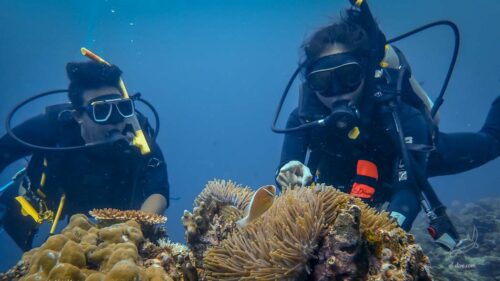Open Water Dive Theory Section 3: Being a Courteous Guest in the Ocean
You’ve mastered the fundamentals in Section 1 and equipped yourself with core safety skills in Section 2. Now, it’s time to learn about the “stage” where you’ll perform those skills: the underwater environment.
In this part of the Amadive guide series, we’ll explore how to read dive conditions, how to interact respectfully with marine life, and your role in protecting this blue world.

1. Understanding Dive Conditions
The marine environment is ever-changing, and understanding these factors will help you plan better dives.
- Temperature & Thermoclines: Water can be colder than you think, and your body loses heat about 20 times faster in water than in air.
- Exposure Suit: A wetsuit or drysuit helps you stay warm and comfortable.
- Thermocline: This is an abrupt boundary between a top layer of warmer water and a bottom layer of colder water. Knowing about it prepares you for a sudden temperature change.
- Visibility: This is the horizontal distance you can see underwater. Visibility can be affected by weather, plankton, or bottom sediment. In low visibility, always stay close to your buddy.
- Currents: This refers to the movement of water.
- Planning: Always start your dive by swimming against the current. That way, when you’re tired and heading back, the current will gently push you back to your starting point.
- If caught in a current: Don’t try to fight it by swimming directly against it. Swim perpendicular to the current to get out of its main flow, or calmly surface and signal for help.
- Waves & Surge: Waves at the surface can cause seasickness. Underwater, wave energy creates a back-and-forth motion called surge. Don’t fight it; relax and move with it.
2. Interacting with Marine Life
Remember, you are a guest in their home. Interacting responsibly is paramount.
- The Golden Rule: Look, Don’t Touch: Most marine creatures have a protective slime coat. Touching them can cause harm. Likewise, coral is a very fragile living animal; a slight touch can kill it.
- Body Control: This is where your buoyancy control skills from Section 2 come into play. By hovering perfectly, you can observe the beauty of the reef without causing damage.
- Potentially Hazardous Animals: Most marine creatures are passive. They only attack when they feel threatened. By keeping your distance and not cornering them, you will be safe. Be aware of creatures like stonefish, sea urchins, and jellyfish.
3. Becoming a Responsible Diver
Every diver is an ambassador for the ocean.
- Leave No Trace: The rule is simple—take only pictures, and leave only bubbles. Don’t take anything as a souvenir (shells, dead coral, sand).
- Protect the Entire Water Planet: Participate in beach or underwater cleanups if possible. Raise awareness among your friends and family about the importance of ocean conservation.
Conclusion for Section 3
Knowledge of the underwater environment not only keeps you safer but also makes your diving experience richer and more meaningful. You are now not just a visitor, but a conscious protector.
Now that you understand the world you’re about to explore, let’s join Amadive to dive deeper into your tools and your own health to ensure every trip is a complete success.
